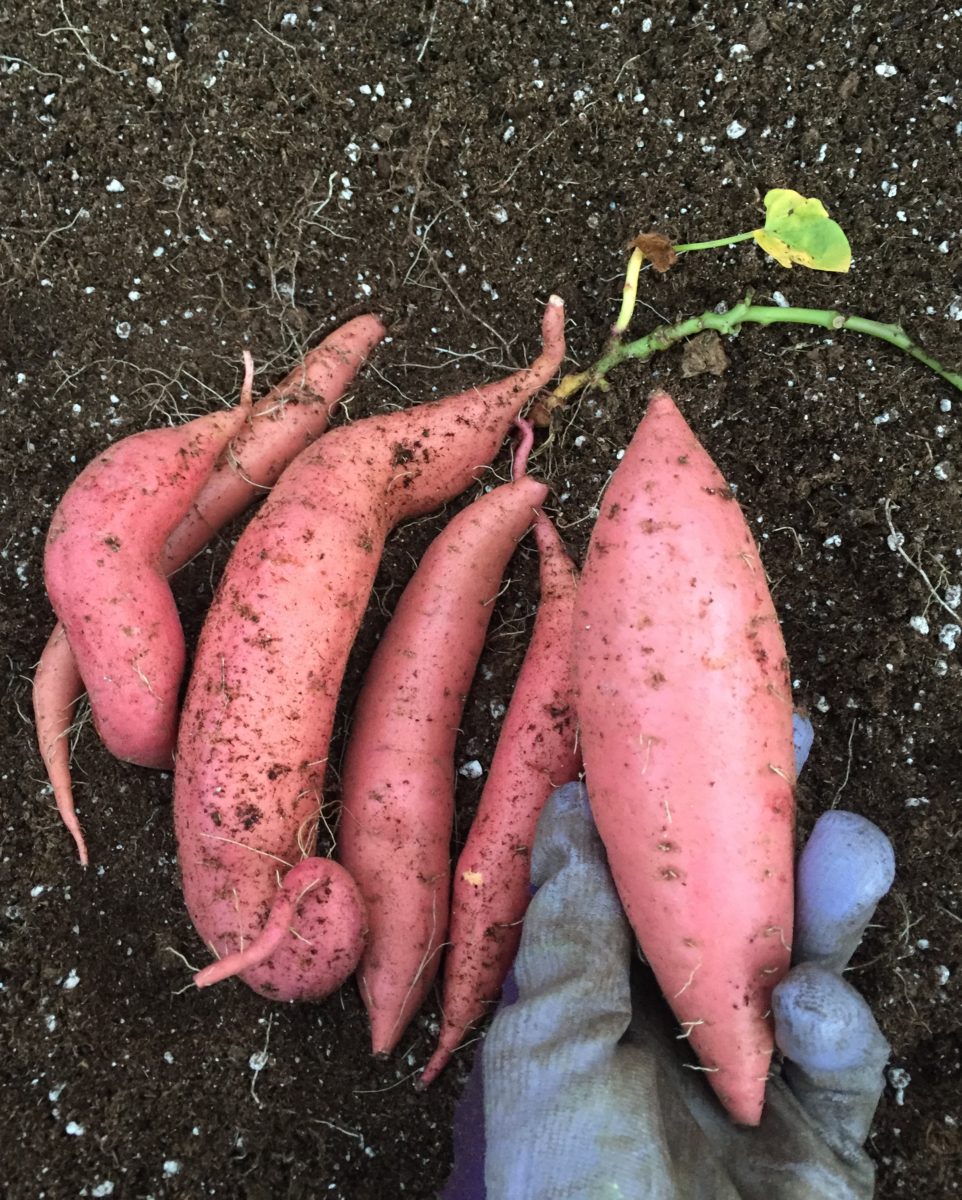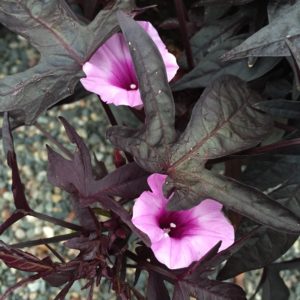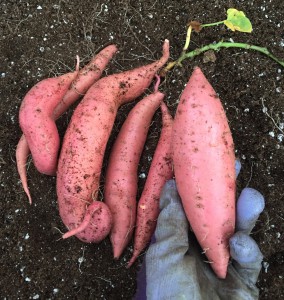
Sweet potatoes are one of those crops that taste great, store great and are versatile in cooking from fries to casserole to soups. However, traditionally they are seen as a southern crop, needing longer growing seasons and more heat than can be found in the north.
But it’s not impossible! With the right set of conditions and the right plants, northern growers in zone 3-2b can definitely enjoy their own crops of these delicious tubers, as well as maintain their plants for years of enjoyable growing.

Sweet potatoes are beautiful vines, so if you are not intending to grow them for their tuber, you can certainly place them in outdoor gardens or planters for a lovely summer display. If lucky, you may even see some flowers on the vines. They are the same family as Morning Glories (Ipomoea) and have the same trumpet style bloom.
The sweet potatoes you grow for tubers in the north will not be the same ones you grow in the southern climates. Especially in Zone 3-2b, our growing season is extremely short, with 90-100 frost-free days. Of those, if you are growing outside count on about 80 days or less where the untouched soil is warm enough for roots.
Happily, short season sweet potatoes exist! They are at the end-range of what a northern grower can manage at about 95-110 days, so some extra work is needed to artificially extend the season, but it’s not terribly hard or difficult, especially if you are already doing this for other crops like winter squash with pre-starting them indoors and providing some early and late-season plastic covering.
Growing Requirements
Like all plants, sweet potatoes have the same basic needs to live; Light, nutrient, water and temperature. And then there are some specifics within these needs if you want them to give tubers. The soil should be well drained, fertile with plenty of organic matter or nutrient, there should be a steady supply of moisture, and they need some added heat from what the northern summer normally provides.
Some needs are easier to provide than others, such as soil. Temperature can be a bit more tricky. If you have a very warm area of soil, you can try planting them outside in rich hilled soil covered with a plastic liner for heat. In a situation like this, you would poke a hole through for each vine, and ensure you have a good way of getting enough moisture beneath the liner as sweet potatoes do not like it to get too dry.

Although some have success with this method, I find that I do not have luck growing them outside, and I like things easier to maintain. Some call it lazy, I’ll go with “efficient”.
Versus hilling and covering the soil, then hoping that the insects or animals do not dig up and eat the roots (plus trying to easily water without a buried soaker hose) I plant my vines in large pots or tubs. And then because I have the ability, I keep these in a simple thin-plastic greenhouse for the season, with a floor of brick to help maintain evening heat. But you do not need a full greenhouse structure. You can have the tubs outside, in a warm spot, with or without a brick underlay, and just cover them with a clear row cover or some loose clear plastic over a frame. Same effect, less work, less cost.
I also pay attention to the soil since I am not planting in the ground. Topsoil is great when the soil life such as worms and other little helpers have access and can keep things from compacting. However, once you move to pots, you need to use a non-compacting planting medium. So I use a good quality potting soil. I have not had issues with disease, so I re-use the same soil each year and simply amend it with new organic fertilizers in the spring before planting.
How to Grow Northern Sweet Potatoes
The overall process once you have a way to provide the growing needs to the sweet potatoes is very simple and straight-forward.
- Take a rooted slip of vine, and plant it gently in a pot of amended soil as early as you can with your extended-season space (or in a plastic covered pre-heated hill if you are going that way). It is important to make sure to plant it with the roots as straight as possible, not curled, or you will have curled tubers that have difficulty gaining any size. Depending on the size of the pot, you can plant 3-4 vines each. I am using fairly large tubs, about 1.5 feet across the top, so I put about 3 vines each.
- Keep the pot in a warmed area, either a greenhouse or under individual covers (mini-greenhouses) in a sunny spot. If possible include the pot in the cover early and late in the season to give extra heat to the roots as well. If planting in hills, you will probably want to give them a row-cover for spring and fall.
- Make sure they get enough water through the summer and fall, but do not over-water them. Your tub should have drainage holes to prevent water sitting on the lower roots.
- Grow them as long as possible through the season, and if you have no sign of diseases save the potting soil to amend again and use the in the spring.
- Harvest, cure, and ENJOY!

At this point, I also take some slips to re-root for overwintering, so I can still grow new potatoes in the spring, but still be able to eat and enjoy ALL the tubers that grew.
So there you have it. Sweet potatoes DO grow in the north. Have you had any luck? I’d love to hear what you did and what success you had in comments (or any questions you have) ^_^

You have given me the inspiration to try these guys again!!!
Thank you. Have always wanteed to try growing them.
[…] Growing Sweet Potatoes in the North January 2, 2016 […]
Where can I get the vines to start with that will grow in zone 2B.
Thanking you in advance.
Hi Pam, Do the sweet potatoes require hilling ? How deep do I plant the slip ? Thanks D
Unlike the common potatoes like russet, sweet potatoes do not grow up. Rather they grow down like other plants (They are the same family as Morning Glories) and the root itself swells to form the tuber. You would plant them deep enough to cover the roots on the slip, as though you were transplanting other rooted vines. I have a bit of information in this video where I talk about overwintering them and spreading the roots so they have room to swell. https://www.youtube.com/watch?v=mTdgqdL5bx8
does it matter what part of the vine you take your cuttings from
I haven’t found that it matters, as long as the section you choose is healthy. I generally prefer the growing end, but that may just be preference. They have all seemed to perform equally once rooted 🙂
[…] Growing Sweet Potatoes in the North January 2, 2016 […]
We cut up regular potatoes to plant, can you do that with sweet potatoes too? If you have to use a slip, where can you get these? We are in Saskatoon saskatchewan
Hi Jian. You cannot plant a sweet potato from cut up pieces like a “regular” potato. They are not from the same species at all. You do need to use a slip. You can try to grow these yourself by sitting a sweet potato piece, that has an eye showing, in water similar to how you may try to sprout an Avocado pit. Else there are a few Canadian suppliers to get slips from in spring. Vesey’s carries some but my best preference has been Mapple Farms.
Hi Pam, do you know if sweet potatos can grow outside instead of in greenhouse in vancouver island where heat might not be enough for the plants to grow?
I can’t say I’m an expert by any means on Vancouver climate (congrats on that long grow season!), but I would say yes given that they can be done (with warming the soil under plastic) on the East coast. Perhaps try some each way and see what works best? You might find the plastic tubs easier to harvest, and with fewer pests, but you may also find that outside is 100% the way to go for you and your space!
Where can we purchase sweet potatoes and yam slips in Alberta?
I tried growing sweet potatoes for the very first time and wish I’d found your page earlier as I have some very curly tubers lol. I’m in the Belleville area of Ontario. We had a decent crop but know that next year’s will be even better. I’ve taken roots from my plants and will overwinter them. If there’s anyone in this area that would like some ease let me know!
Here in the state of Florida, semitropical warm winter south FL, mild winter subtropical central FL & cool winter subtropical, climate zones 10, 9 & 8 the sweet potato grows profusely in all these areas & Florida is a sweet potato producing area.